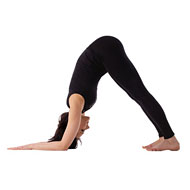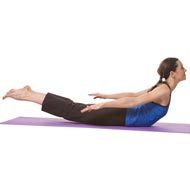- Mountain Pose
- Five pointed star pose
- Goddess Pose
- Cresent Moon Pose
- Chair pose
- Warrior I Pose
- Warrior II Pose
- Side Angle Pose
- Triangle Pose
- High Lunge
- Revolved Side Angle Pose - Parivrtta Parsvakonasana
- Wide-Legged Forward Bend - Prasarita Padottanasana
- Lord of the Dance Pose
- Garland Pose
- Standing Split
- Revolved Triangle Pose
- Extended Triangle Pose
- Low Lunge
- Upward Forward Fold
- Big Toe Pose
- Extended Side Angle Pose
- Standing Forward Bend
Dolphin Pose
The dolphin pose also sometimes referred to as the puppy pose in yoga, is a standing, mild inversion posture. This asana helps in working the various muscles in the shoulders, abdomen and the upper back.
This posture in an inverted ‘v’ position with the forearms and toes on the floor on the floor with the rest of the body curved upwards in a v-like formation.
The yoga dolphin pose is a great way to open up the shoulders while strengthening the arms, legs as well as the core body.
Steps :
This asana is relatively easy to perform as compared to some of the other difficult postures performed in yoga. The anatomical focus of this posture is the upper back. A systematic explanation of this asana can help a beginner get this position right and therefore it is advisable to learn it from a trained yoga expert who can guide you properly. Some of the easy to follow dolphin pose steps are as under:
- Position yourself on the floor with the support of your hands and knees. Place the knees directly below the hips and the forearms on the ground with the shoulders directly above the wrists. Press the arms and palms firmly together and into the floor.
- While exhaling, curl the toes, and lift the knees away from the ground. Lift the heels slightly off the floor gently so that you are balancing the lower body on the toes.
- Lengthen the tailbone away from the pelvic region and press it closer to the pubic region. Lift the entire body towards the ceiling in a way where the ankles and the inner legs draw up into the groin region.
- Press the forearms into the floor and firm the shoulder blades while holding the head between the upper arms and facing downwards.
- Hold this posture for at least 30 seconds and then gently bend the knees to release them, while exhaling normally.
Precautions :
Even though this yoga asana is easy to perform, there are certain precautions that you will need to take. People with shoulder and neck injuries should keep their legs bent while practicing this pose.
Beginner’s Tip :
Beginner’s can lift their elbows while performing the dolphin pose while keeping their wrists pressed into the floor. This helps in opening up the shoulders without any additional stress. This is also a good beginner’s tip for the dolphin pose.
You can also use a pillow or folded blanket to support the head to reduce strain on the neck region.
Another good tip while performing this pose is that you can try walking your feet towards the elbows while in the v-like posture. This helps in building good shoulder and arm strength. The best time to perform this asana is early in the morning so that you can stay relaxed and revitalized throughout the day.
Benefits To Body Parts :
By regularly performing the dolphin pose benefit to body parts like the upper back, shoulders, arms, abdomen, hamstrings and legs is tremendous. Some of the well-known benefits of the dolphin pose are as under:- It helps in stretching the shoulders, spine, arches, hamstrings and calves.
- It strengthens and increases the flexibility of the spine, arms and legs.
- It helps relieve stress and tension in the upper back region and is therefore especially beneficial to those whose jobs require them to sit for long periods.
- It helps in toning the core muscles and helps in opening the chest, armpits and shoulders.
Therapeutic Applications :
- It relieves the symptoms of menopause like pain, irritation, mood swings and even lethargy.
- This asana performed with some head support, helps in relieving menstrual discomfort.
- It helps in improving digestion and is therapeutic for health conditions like asthma, high blood pressure, sciatica and flat feet.
- It relieves back pain, insomnia, fatigue and headaches.
- It can even prevent osteoporosis if practiced regularly.
- It helps calm the mind and even relieves mild depression and mental stress.
Variations :
One of the variations for dolphin pose is the dolphin plank pose, also known as the Makara Adho Mukha Svanasana in yoga. This variation pose helps in strengthening the upper body, back, abdominal muscles as well as the legs. The basic steps for performing this variation pose are as under:
- You can start in the original dolphin pose and walk your feet backwards until the torso is parallel to the floor and the shoulders are exactly above the elbows.
- Firmly press the elbows are forearms against the floor while moving the shoulder blades away from the spine. Similarly spread the collarbones away from the sternum.
- Press the thighs towards the ceiling while keeping the tailbone closer to the floor and stretch out the leg muscles towards the heels. Elevate the head slightly from the neck and look straight down towards the floor while keeping the eyes and throat relaxed.
- Hold this position for at least 30 seconds and then gently release while exhaling.
This variation for the dolphin pose helps in strengthening arms, legs as well as the core body. It also helps in relaxing the mind and can effectively treat anxiety and mental tension. Beginners can perform this asana by supporting their head on a block to relieve neck tension. People who have neck and shoulder injuries should either avoid doing this asana or practice it under professional supervision.
Preparatory Pose :
- Standing Forward Bend (Uttanasana),
- Side Plank Pose (Vasisthasana)
- Cow Face Pose (Gomukhasana). The Gomukhasana in this case is done only with the arms as a preparatory pose for the dolphin pose
Follow Up Pose :



